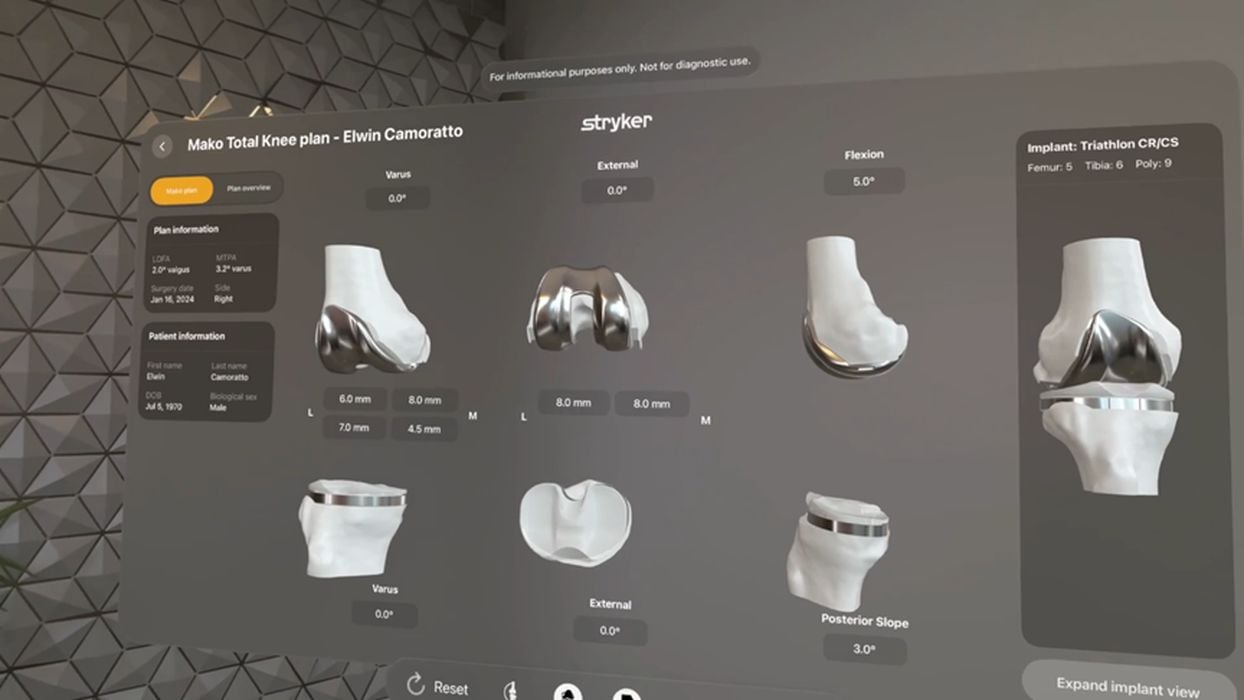
Charles R. Goulding and Preeti Sulibhavi explore how Stryker’s integration of Apple’s Vision Pro and 3D printing technology is revolutionizing surgical precision and patient outcomes in the healthcare industry.
For those looking for the next biggest thing, look no further than Apple Vision Pro. Vision Pro seamlessly blends digital content with the physical world, unlocking powerful spatial experiences in an infinite canvas. And with the unique capabilities of visionOS, healthcare developers are creating new apps that were not previously possible, transforming areas such as clinical education, surgical planning, training, medical imaging, behavioral health, and more.
Stryker is working to integrate this technology, in collaboration with the Hospital for Special Surgery (HSS).
HSS surgeons shared that the current first level of app development brings the Stryker computer screen into his Vision Pro field of vision, so he only must move his eyes, not his head (which would require looking away from his surgery) to integrate the data and surgical guidance. This is a game-changer for surgeries, especially for robotic ones.
More than 1 million Americans receive a knee or hip replacement surgery annually, and that number will continue to rise as the population ages. When surgeons use Stryker’s Mako SmartRobotics for total hip, total knee, and partial knee replacements, it can help lead to more positive patient outcomes like less pain and shorter recovery times, when compared to traditional joint replacement surgeries. With the new “myMako” app, Stryker is extending a surgeon’s experience in and beyond the operating room with Apple Vision Pro and iPhone. For better preparation, myMako enables surgeons to visualize and review patients’ Mako surgical plans at any time in a brilliant, immersive visual experience. Spatial computing for the healthcare industry “on steroids,” so to speak.
Future levels of development could foresee surgeons co-operating across the country or the world. Also enabled by the enhanced visualization is more focused supply chain management of the various prosthetic sizes. This is where 3D printing comes in. If surgeons can hone in on more specific prosthetic and implant sizes, shapes and customization, these MedTech items can be 3D printed on premises as opposed to ordering batches of standard implants that have to be modified for each patient’s unique body composition.
The surgeons are very enthusiastic about the possibility of Stryker engineers eventually getting access to the power of the Vision Pro’s numerous cameras so that he would have “super vision” during surgery. Zimmer and other joint replacement companies as well as GE and Siemens for creating images are developing similar tools – a whole new frontier for the healthcare industry to explore.
The Vision Pro’s weight must be modified in future versions, including its battery. It is a bit heavy, especially since it is to be worn on one’s face/head. The recharging time could also be improved.

The Research & Development Tax Credit
The now permanent Research & Development Tax Credit (R&D) Tax Credit is available for companies developing new or improved products, processes and/ or software.
3D printing can help boost a company’s R&D Tax Credits. Wages for technical employees creating, testing and revising 3D printed prototypes can be included as a percentage of eligible time spent for the R&D Tax Credit. Similarly, when used as a method of improving a process, time spent integrating 3D printing hardware and software counts as an eligible activity. Lastly, when used for modeling and preproduction, the costs of filaments consumed during the development process may also be recovered.
Whether it is used for creating and testing prototypes or for final production, 3D printing is a great indicator that R&D Credit eligible activities are taking place. Companies implementing this technology at any point should consider taking advantage of R&D Tax Credits
Conclusion
For patients who need customized implants for their knee or hip replacement surgery, Stryker’s integration of Apple Vision Pro can only improve their health outcomes by making it easier for surgeons to adjust the placement of customized implants to achieve the final position more accurately before incisions, thanks to spatial computing and 3D printing.
The authors would like to thank Anita MacDougall, a long-time Apple product user and medical development observer for inspiring us to write this article.
